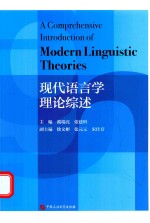

现代语言学理论综述PDF电子书下载
- 电子书积分:9 积分如何计算积分?
- 作 者:戴瑞亮,张建科主编;徐文彬,张元元,宋佳音副主编
- 出 版 社:东营:中国石油大学出版社
- 出版年份:2016
- ISBN:9787563654659
- 页数:191 页
Part Ⅰ Structuralism 2
Chapter 1 Saussure:Father of Modern Linguistics 2
1.1 Ferdinand de Saussure 2
1.2 Nature of the linguistic sign 2
1.3 The relational nature of language units 3
1.4 Syntagmatic and paradigmatic relations 4
1.5 Langue and parole 6
1.6 Synchronic and diachronic studies 7
1.7 Saussure's influence 8
Chapter 2 American Structuralism 11
2.1 Early period:Boas and Sapir 12
2.1.1 Franz Boas 12
2.1.2 Edward Sapir 14
2.1.3 Linguistic relativity 23
2.1.4 Linguistic relativity and cognitive linguistics 25
2.2 Leonard Bloomfield 29
2.2.1 Bloomfield the man 30
2.2.2 Bloomfield and behaviorism 30
2.2.3 Bloomfield and his Language 33
2.2.4 Structuralism and language teaching 37
2.3 Conclusion 38
Part Ⅱ Functionalism 40
Chapter 3 The Prague School 40
3.1 Historical background 41
3.2 Theories of language 42
3.3 Phonology and phonological opposition 46
3.4 Distinctive Features 49
3.5 Functional Sentence Perspective(FSP) 51
Chapter 4 The London School 58
4.1 Malinowski's theories 58
4.2 Firth's theories 60
4.3 Halliday and Systemic-Functional Grammar 62
4.3.1 Halliday's philosophy of language 63
4.3.2 Systemic grammar 65
4.3.3 Functional grammar 68
4.3.4 Halliday and sociolinguistics 74
Part Ⅲ Generativism 83
Chapter 5 Transformational-Generative Grammar 83
5.1 Chomsky's philosophy of language 83
5.1.1 Background 83
5.1.2 What is language? 85
5.1.3 The Innateness Hypothesis 86
5.1.4 Universal grammar and particular grammar 87
5.1.5 What is a generative grammar? 88
5.2 Stages of development of TG Grammar 89
5.2.1 The Classical Theory 89
5.2.2 The Standard Theory 92
5.2.3 The Extended Standard Theory 94
5.2.4 Later Theories 96
5.3 A comparison between TG Grammar and structural grammar 97
Part Ⅳ Cognitivism 102
Cahpter 6 Metaphor and Metonymy 102
6.1 Metaphor 102
6.1.1 Metaphor in cognitive linguistics 103
6.1.2 Features of metaphor 107
6.1.3 The experiential basis of metaphor 111
6.2 Metonymy 112
6.3 Metaphor metonymy interaction 118
Chapter 7 Image Schema and Polysemy 120
7.1 Image schema 120
7.1.1 Containment schema 121
7.1.2 Path schema 123
7.1.3 Force schema 124
7.2 Polysemy 126
7.2.1 Prepositions 127
7.2.2 Modal verbs 130
Chapter 8 Categorization and Idealized Cognitive Models 133
8.1 Categorization 133
8.1.1 The classical theory 133
8.1.2 The prototype theory 136
8.1.3 Levels of categorization 139
8.2 Idealized cognitive models 139
8.2.1 Characteristics of ICMs 140
8.2.2 Typicality effects from ICMs 141
Chapter 9 Iconicity 150
9.1 Iconicity of order 151
9.1.1 Temporal order 151
9.1.2 Spatial order 152
9.1.3 Culture-motivated order 155
9.1.4 Word order related to asymmetry in cognition 156
9.2 Iconicity of distance 157
9.2.1 Causation 157
9.2.2 Coordination 158
9.2.3 Possession 159
9.2.4 Negation 159
9.2.5 Internal structure of word 160
9.2.6 Multi-modifier construction 160
9.2.7 Attributive clause 161
9.2.8 Subjunctive mood 162
9.3 Iconicity of quantity 162
9.3.1 Word form 163
9.3.2 Emphatic sentence 163
9.3.3 Exclamatory sentence 164
9.3.4 Sentence of politeness 164
9.3.5 Other structures 165
9.4 Philosophical interpretation of iconicity 166
9.5 Iconicity and other competing principles 168
9.5.1 Iconicity and economy 168
9.5.2 Iconicity and pragmatic principles 169
9.5.3 Iconicity and abstract syntactic conventions 170
Chapter 10 Conceptual Blending 172
10.1 The origins of Blending Theory 173
10.2 Towards a theory of conceptual integration 174
10.3 The nature of blending 179
10.3.1 The elements of conceptual blending 179
10.3.2 Further linguistic examples 181
10.3.3 Non-linguistic examples 183
10.4 Contrasting Blending Theory with Conceptual Metaphor Theory 184
Bibliography 187
- 《SQL与关系数据库理论》(美)戴特(C.J.Date) 2019
- 《联吡啶基钌光敏染料的结构与性能的理论研究》李明霞 2019
- 《情报学 服务国家安全与发展的现代情报理论》赵冰峰著 2018
- 《英汉翻译理论的多维阐释及应用剖析》常瑞娟著 2019
- 《新课标背景下英语教学理论与教学活动研究》应丽君 2018
- 《党员干部理论学习培训教材 理论热点问题党员干部学习辅导》(中国)胡磊 2018
- 《虚拟流域环境理论技术研究与应用》冶运涛蒋云钟梁犁丽曹引等编著 2019
- 《当代翻译美学的理论诠释与应用解读》宁建庚著 2019
- 《程序逻辑及C语言编程》卢卫中,杨丽芳主编 2019
- 《环境影响评价公众参与理论与实践研究》樊春燕主编 2019
- 《大学计算机实验指导及习题解答》曹成志,宋长龙 2019
- 《中国当代乡土小说文库 本乡本土》(中国)刘玉堂 2019
- 《异质性条件下技术创新最优市场结构研究 以中国高技术产业为例》千慧雄 2019
- 《中国铁路人 第三届现实主义网络文学征文大赛一等奖》恒传录著 2019
- 《莼江曲谱 2 中国昆曲博物馆藏稀见昆剧手抄曲谱汇编之一》郭腊梅主编;孙伊婷副主编;孙文明,孙伊婷编委;中国昆曲博物馆编 2018
- 《中国制造业绿色供应链发展研究报告》中国电子信息产业发展研究院 2019
- 《中国陈设艺术史》赵囡囡著 2019
- 《《走近科学》精选丛书 中国UFO悬案调查》郭之文 2019
- 《大学生心理健康与人生发展》王琳责任编辑;(中国)肖宇 2019
- 《清至民国中国西北戏剧经典唱段汇辑 第8卷》孔令纪 2018
